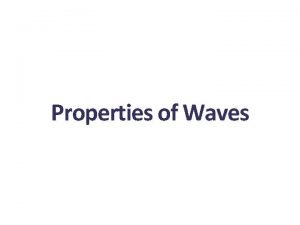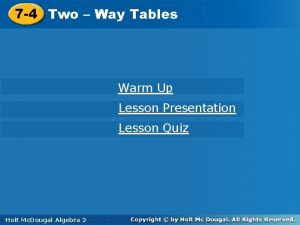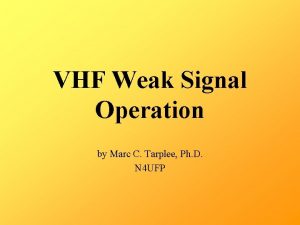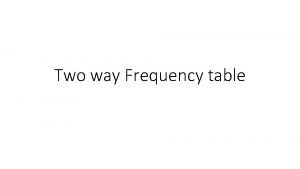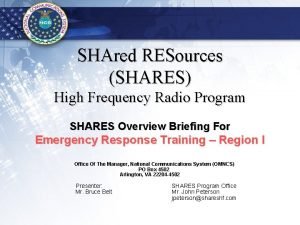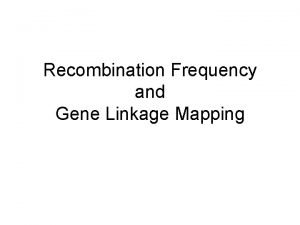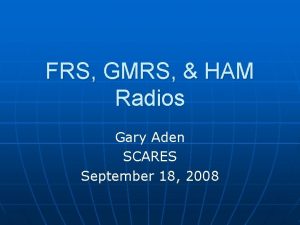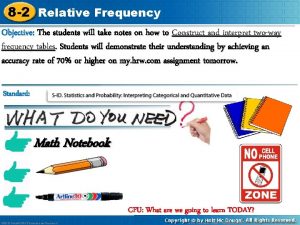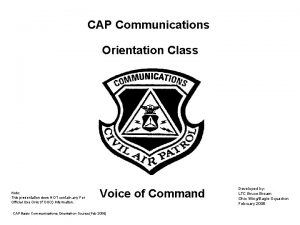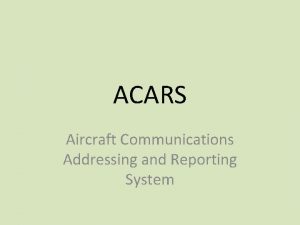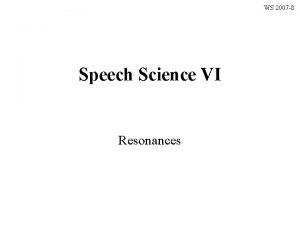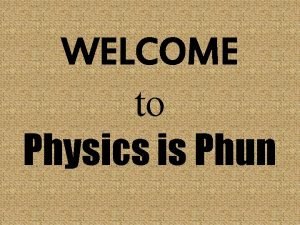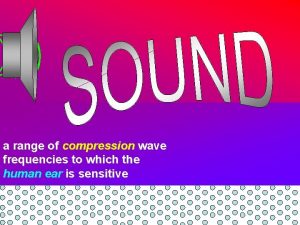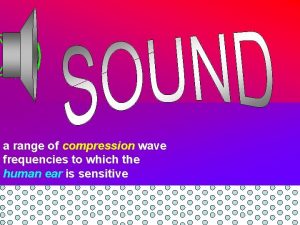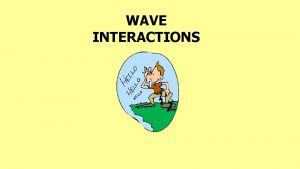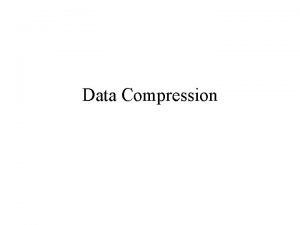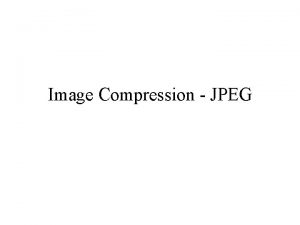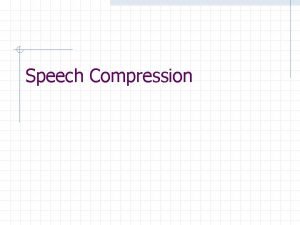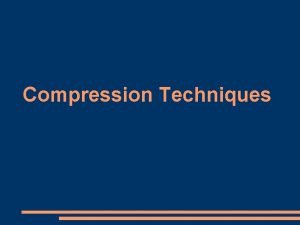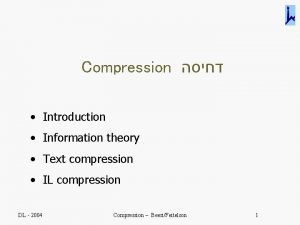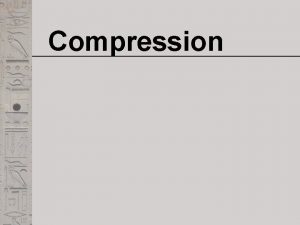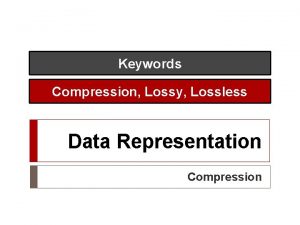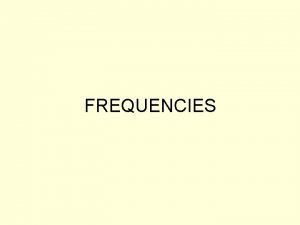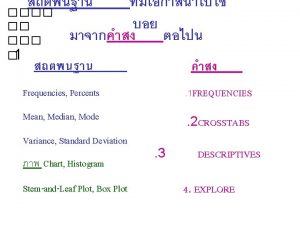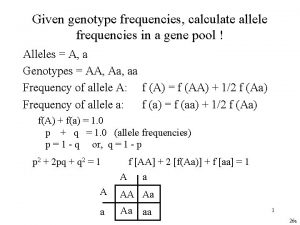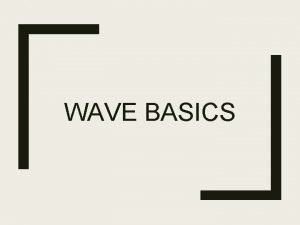a range of compression wave frequencies to which































- Slides: 31

a range of compression wave frequencies to which the human ear is sensitive

Figure 14 -1 Vibrations make waves A vibrating tuning fork disturbs the air, producing alternating high-pressure regions (condensations) and low-pressure regions (rarefactions), which form sound waves.

Sounds are produced by vibrating matter. 1. reeds 3. membranes 2. strings 4. air columns Sound is a mechanical wave (longitudinal). It will not travel through a vacuum.

• PITCH = The impression about the frequency of Sound • high pitched – high frequency (ex: piccolo) • low pitched – low frequency (ex: fog horn) • The frequency range for normal human hearing is. between 20 Hz and 20, 000 Hz. (for younger people, older people lose the higher frequencies) • Infrasonic or subsonic = Sounds below 20 Hz • Ultrasonic = frequencies above 20, 000 Hz

Range of Some Common Sounds

Compression waves travel through air or along springs. These waves travel with areas of compression and rarefaction. The medium does not travel from one place to another, but the pulse that travels.

Sound wave requires medium Any matter will transmit sound, whether it is a solid, liquid or a gas. However; sound cannot travel through a vacuum. No Sound DING VACUUM

The velocity of sound in air depends on the air temperature. The speed of sound in dry air is 331. 5 m/s at 0 ºC. This speed increases with temperature: about 0. 6 m/s º for every 1 C increase in temperature.

Speed of Sound • The speed of sound in dry air at 00 C is about 331 m/sec. (1200 km / hr) [or ~. 000, 001 x the speed of light of 300, 000 km / sec] • So air at room temperature (~20 o. C) is ~340 m/sec. • QUESTION : . How far away was the strike if there is a 3 second delay between the lightning flash and the sound of the thunder? • 340 m/sec x 3 sec = 1020 m, over 1 km (~2/3 mile) away

Sound generally travels fastest in solids and slowest in gases, but there are some exceptions. Medium Velocity (m/s) Air 331 Carbon dioxide 260 Helium 930 Hydrogen 1270 Oxygen 320 Water 1460 Sea water 1520 Mercury 1450 Glass 5500 Granite 5950 Lead 1230 Pine wood 3320 Copper 3800 Aluminium 5100

Speed of Sound • The speed of sound in a material does NOT depend on its density (mass per unit volume [g/cm 3 ]). • The speed of sound in a material DOES depend on the elasticity of a material. • Elasticity = the ability of a material to change shape in response to an applied force, then resume its original shape when the force is removed. • Steel is elastic, putty is inelastic. • Sound travels 15 times faster in steel than in air and about 4 times faster in water than in air.

Figure 14 -4 Intensity of a point source The energy emitted from a point source spreads out equally in all directions. Since intensity is power divided by area, I = P/A = P/(4πR 2), where the area is that of a spherical surface. The intensity then decreases with the distance from the source as 1/R 2. (figure not to scale).

LOUDNESS • The intensity of a sound is proportional to the square of the amplitude of the sound wave. (i = ka 2) • Loudness is measured in decibels (d. B) MICROPHONE VIBRATING LOUDSPEAKER • 1 AMPLITUDE OSCILLOSCOPE 10 100 • The decibel scale is logarithmic, increasing by factors of 10 1000

Sound Levels Decibel or d. B scale • I 0 is the threshold of hearing • Threshold of pain is 120 d. B

Figure 14 -5 Sound intensity levels and the decibel scale

Figure 14 -6 Protect your hearing Continuous loud sounds can damage hearing, so our ears may need protection as shown here. The intensity level of lawn mowers is on the order of 90 d. B.

Table 14 -2 Sound Intensity Levels and Ear Damage Exposure Times

Intensity Range for Some Common Sounds

Forced Vibration • Sounding boards are used to augment (increase) the volume (amplitude) of a vibrating object (like a string). STRINGS SOUNDING BOARD

Natural Frequency • Everything vibrates, from planets and stars to atoms and almost everything in between. • A NATURAL FREQUENCY is one at which minimum energy is required to produce forced vibrations • and also requires the least amount of energy to continue this vibration

Resonance – when the frequency of a forced vibration on an object matches the object’s natural frequency, a dramatic increase in amplitude of the vibrations occurs. • For example, a swing, or the hollow box parts of musical instruments are designed to work best with resonance. • In order to resonate, an object must be elastic enough to return to its original position and have enough force applied to keep it moving (vibrating)

Interference • Sound waves interfere with each other in the same way as all waves. • Constructive interference - augmentation • Destructive interference - cancellation

Beats • BEATS - A periodic variation in the loudness of sound. . (faint then loud, faint then loud and so on … ) • What is the frequency when a 262 Hz and a 266 Hz tuning fork are sounded together ? • The 262 Hz and 266 Hz forks will produce 4 beats per sec. and the tone heard will be halfway between at 264 Hz as the ear averages the frequencies.

Sound – Beats Superposition leads to beats – variation in loudness

Propagation Speed In a string v depends on the tension T and linear mass density μlin In an air column v depends on temperature T

The Doppler Effect n n An observer of the wave crests behind or away from the direction of motion would identify a lower frequency due to a greater travel distance from the vibration source. This apparent change in frequency is called the DOPPLER EFFECT after Christian Doppler (1803 – 1853) The greater the speed, the greater the Doppler effect The police and weather reporters use the Doppler effect of radar waves to measure the speeds of cars or water in clouds.

The Doppler Effect Vibrating in a stationary position produces waves in concentric circles. (because the wave speed is the same in all directions) Vibrating while moving at a speed less than the wave speed produces nonconcentric circles. The wave crests in the direction of motion occur more often (have a higher frequency) due to a shorter travel distance.

Doppler Effect n n If source (s) is moving, detected frequency (fd) changes If detector (d) is moving, detected frequency changes ± • Top sign when moving away from • Bottom sign when moving towards

Astronomy and the Doppler Shift n n Astronomers can measure the Doppler Shift of a moving object. The radio wave has a known frequency for stationary objects. If target is moving away, waves in the signal will be stretched, and will have a lower frequency. The Doppler shift is called “Red shift” if v > 0 (moving away) since the wavelength is getting longer and the frequency shorter “Blue Shift” if v < 0 (moving closer) since the wavelength is getting shorter and the frequency higher (recall that blue light is higher in frequency than red)

Bow Waves n When the vibration source is moving at the same speed as the wave front, a bow wave is produced. n In aircraft this is called the “sound barrier”. It is not a real barrier, but is where the wave crests build up on each other at the speed of sound. n Speedboats and supersonic aircraft travel in front of their bow waves.

Shock Waves n Shock waves produced by supersonic aircraft are the 3 -dimensional version of the V-shaped bow wave produced by boats. n On the ground this is noted as a sonic boom. BOOM !
 A piano emits frequencies that range
A piano emits frequencies that range Scale of electromagnetic waves
Scale of electromagnetic waves As compared to long-range forecasts, short-range forecasts
As compared to long-range forecasts, short-range forecasts Longitudinal vs transverse wave
Longitudinal vs transverse wave Long waves and short waves
Long waves and short waves Difference between full wave and half wave rectifier
Difference between full wave and half wave rectifier Longitudinal vs transverse waves
Longitudinal vs transverse waves Half wave rectifier definition
Half wave rectifier definition Half wave and full wave rectification
Half wave and full wave rectification P and s wave arrival time chart
P and s wave arrival time chart Rectified sine wave fourier series
Rectified sine wave fourier series Nature of sound wave
Nature of sound wave Wave wave repeating
Wave wave repeating Half-wave symmetry
Half-wave symmetry Mechanical and electromagnetic waves venn diagram
Mechanical and electromagnetic waves venn diagram An example for mechanical wave
An example for mechanical wave Wavelength formula triangle
Wavelength formula triangle How to find conditional relative frequencies
How to find conditional relative frequencies Jt6m frequencies
Jt6m frequencies What is conditional relative frequency
What is conditional relative frequency Marginal relative frequency
Marginal relative frequency What are joint relative frequencies
What are joint relative frequencies Shares radio frequencies
Shares radio frequencies Recombination rate
Recombination rate What is gene frequency in genetics
What is gene frequency in genetics Joint relative frequency vs conditional relative frequency
Joint relative frequency vs conditional relative frequency Aden
Aden Lesson 8-2 relative frequency and probability
Lesson 8-2 relative frequency and probability Ef johnson 5112
Ef johnson 5112 Acars message format
Acars message format Formant frequencies
Formant frequencies Formant frequencies
Formant frequencies
